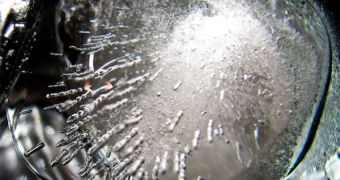Experts have known for a very long time that water is a very peculiar liquid. Its anomalies allow for it to move in nature the way it does, and also to allow a host of other biological processes, including the little thing called life, take place. Its properties are still puzzling to physicists and chemists, as they don't quite enter all scientific classifications a liquid of its type is supposed to. Further adding to this, researchers in India and Italy have recently announced what could be the discovery of two new forms of water, trapped at temperatures way below the freezing point, but which is not quite ice.
One of the weird things about water is the fact that it gets less dense when it freezes and turns into a solid, rather than more dense, as with most other liquids. Additionally, rather than being more dense right before freezing, near 0 degrees Celsius, it becomes so at four degrees Celsius, an anomaly that has had researchers scratching their heads for quite some time now. Additionally, ice floats on liquid water, which allows for lakes to remain unfrozen at the bottom during the harshest winters. This means that life buried deep within the lake can survive until next summer, or even for millions of years, in basic forms.
Boston University in Massachusetts expert Gene Stanley proposed, back in 1992, that two very complex forms of water could potentially exist. He said that the thing that made water retain its bizarre properties was mostly its type of bonds, called hydrogen bonds. These connections keep water molecules together in liquids, but, in ice, they stretch “at arm's length,” and leave much room between its components, Nature News reports. Stanley added that, when kept at very low temperatures, and under extremely high pressure, water could potentially differentiate within two separate forms.
One such form is the low-density liquid (LDL) water, in which the hydrogen bonds create an open, sparse network of water molecules, while the other is the high-density liquid (HDL) water, in which some of the bonds break, and the molecules are kept very closely together. The researcher learned that, through a process called “phase transition” (the same one that happens when liquid water turns into ice), LDL could become HDL and vice-versa. He hypothesized that the four-degree Celsius high-density anomaly could play a part in the lower-temperature version of melting and freezing as well.
Now, experts from the University of Pisa, in Italy, and the Indian Institute of Science, in Bangalore, believe that they may have discovered the elusive forms. While Stanley is thrilled with the discovery, others say that the team behind the potential new find is wrong. They argue that the water the scientists analyzed is not pure, and that, therefore, the results cannot be considered.
“The liquid that the authors are investigating is not pure water, but rather what is left over when most of the water has crystallized out. The composition is unknown. My informed guess is that the observations refer to a thick soup of TEMPOL [an organic 'probe' molecule] and assorted soluble impurities,” Arizona State University water specialist Austen Angell explained.

 14 DAY TRIAL //
14 DAY TRIAL //